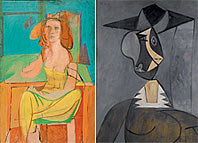
You could almost call Pablo Picasso, who never set foot in the United States, the most influential American artist of the twentieth century. In the years before World War II, modernists in New York knew more about Picasso than they did about Homer or Eakins. They treated any Picasso that made it across the Atlantic as a piece of the true modern cross, studying each line, drip, and shift of style for clues about what modernism meant and where art was going. Not only was Picasso the main creator of Cubism; he was also a great representational painter and Surrealist. He helped invent collage, transformed sculpture, and, in Guernica, made the greatest antiwar painting of the century. In New York studios, he seemed inescapable, both as an inspiration and a reason for despair. What was left after Picasso?
“Picasso and American Art,” at the Whitney, is an account of the revolutionary impact of this one extraordinary figure. The show will focus upon (but not be limited to) nine Americans powerfully affected by Picasso: Stuart Davis, Willem de Kooning, Arshile Gorky, John Graham, Jasper Johns, Roy Lichtenstein, Jackson Pollock, David Smith, and Max Weber. Works of Picasso’s, many borrowed from abroad, will be juxtaposed with homegrown art to demonstrate how Americans both resisted and emulated the master. The formal links should be fairly obvious. What will prove interesting are the more subtle connections and interplays of sensibility. Picasso was not a good boy. He violated boundaries. He was a celebrity, unpredictable, cruel to women. His ambition was unseemly. What did Picasso liberate in the provincial American heart—and art?
—Picasso and American Art, Whitney Museum of American Art; September 28 through January 28.